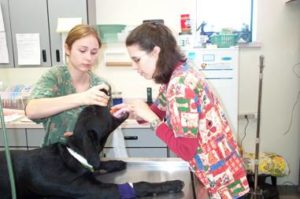Most pets go home the same day as their dental cleanings. It is important to remember that they may still be a little sleepy from the anesthetic and events of the day. Some also may be a little sore from having plaque/tartar removed or from having teeth removed. Depending on the condition of the oral health and what was done, antibiotics and/or pain medications may be sent home to complete their treatment. In these cases, directions will be on the bottle labels and within the go-home instructions.
Once an appointment is scheduled for your pet’s teeth cleaning, the doctor reviews your pet’s chart and determines if any pre-anesthetic testing is recommended to increase the safety of the procedure. Unlike humans, pets do not willingly open their mouths and allow us to scrape the plaque and tartar from their teeth. Anesthesia is important to ensure that your pet holds still, is not painful and that its airway is protected.
When you and your pet arrive to check in for the dental cleaning, one of our licensed veterinary technicians (similar to a registered nurse) will review the anesthetic consent form and doctor’s recommendations for your pet. These technicians are trained to answer your questions and explain the doctor’s recommendations. This usually takes about ten to fifteen minutes. Once you feel comfortable with their explanations, they will ask for your signature and a contact number where we can reach you while your pet is with us. This contact number is very important. While emergencies are rare, they do happen and having a viable contact number is crucial to providing your pet with the level of care you desire. Most often this contact information is used to keep you up-to-date on the progress of your pet’s dental and to discuss any additional findings during the dental evaluation. This may include advising you about additional procedures, such as radiographs and/or extractions that would be recommended. If we are unable to contact you, we are frequently forced to delay this additional work which denies your pet from receiving the best dental care and can result in additional costs and inconvenience to you associated with anesthetizing your pet again and bringing it back for an additional appointment.
Oravet is applied following the polishing of the teeth. This “sealant” bonds electrostatically with the teeth and helps reduce plaque and tartar accumulation. The oravet applied while your pet is under anesthesia is much more concentrated than the home applied product. Not only does it help reduce dental disease, but it also serves as a foundation for application of the home product. (For more information on Oravet, visithttp://www.oravet.us.merial.com)
 While anesthesia does represent a risk, Kulshan uses the safest anesthetics and anesthetic protocols available to maximize your pet’s safety. We also utilize the information gathered from lab work and EKG’s to make the best decisions related to which anesthetics to use and how much to give. While your pet is under anesthesia, various monitors similar to those used in human hospitals are used to monitor your pet’s vital signs as well.
While anesthesia does represent a risk, Kulshan uses the safest anesthetics and anesthetic protocols available to maximize your pet’s safety. We also utilize the information gathered from lab work and EKG’s to make the best decisions related to which anesthetics to use and how much to give. While your pet is under anesthesia, various monitors similar to those used in human hospitals are used to monitor your pet’s vital signs as well.
How Often Does My Dog Need a Dental Cleaning?

Most veterinary dentists recommend that dogs should have their teeth cleaned once a year. However, this can largely depend on the breed and if the dog has any pre-existing health conditions. Larger dogs tend to need one dental cleaning per year, or in some cases, less often. Smaller dogs sometimes need two visits a year to prevent teeth loss. Because of high demand for reduced-cost dental services, at Emancipet we focus our efforts on dogs with moderate to severe dental disease.
At Emancipet, a dental evaluation can be done as a part of your pet’s regular wellness visit. Just ask the technician at check-in for a dental exam and the doctor will look at your dog or cat’s teeth and let you know whether a cleaning or extractions may be needed. Please note that dentistry is not available at all Emancipet clinics- feel free to ask at check-in or call our Resource Center for information about services offered in your area.
If your pet exhibits the following signs, you should consider getting their teeth cleaned immediately. Discolored or broken teeth, excessive bad breath, reduced appetite, and bloody drool indicate that your dog needs immediate dental health. Don’t hesitate to contact a veterinarian about your dog’s teeth, even if you aren’t sure something is wrong.
If you’re curious about your pet’s individual dental needs, it’s a good idea to take your pet in for a dog dental check up. This doesn’t have to be done as part of a special appointment. Most vets are more than happy to take a quick look at your dog’s teeth and tell you if/when they should come in for a cleaning when asked. However, it is likely that a separate appointment will be necessary for the actual cleaning.
What are the signs of dental health problems in dogs?
There are a number of signs and symptoms that can indicate that your dog has dental health issues that need veterinary attention. If you notice any of the following symptoms its time to call your vet to book a dental appointment for your pooch:
Additional symptoms associated with poor dental health in dogs include:
Should I Get My Dog’s Teeth Cleaned?
When rough tartar accumulates on tooth surfaces and touches the gum line it is time for a professional oral assessment, treatment, and prevention visit.